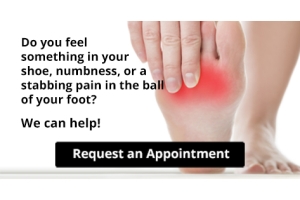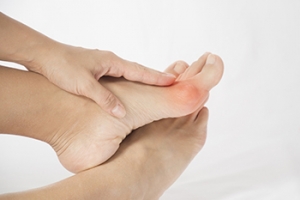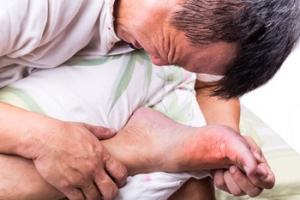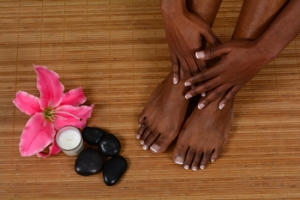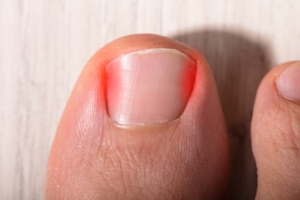
Why Live with Pain and Numbness in Your Feet?
Signs and Causes of Bunions
 A very common foot condition that causes a bony lump to appear on the base of the big toe is known as a bunion. Bunions occur because the joint is pulled out of alignment, causing the big toe to turn towards the rest of the toes. Bunions tend to worsen over time and common symptoms can include a deformity in the joint of the big toe, a bony lump, pain, redness, swelling, or an overlapping of the big toe over the smaller toes. Bunions can have a variety of causes, such as wearing shoes that don’t fit correctly, arthritis, old age, and even genetics. Bunions can be treated both surgically or non-surgically through methods such as orthotics, or pain relief medicine. If you are experiencing a painful bunion, consulting with a podiatrist is suggested in order to find a treatment method that is best for you.
A very common foot condition that causes a bony lump to appear on the base of the big toe is known as a bunion. Bunions occur because the joint is pulled out of alignment, causing the big toe to turn towards the rest of the toes. Bunions tend to worsen over time and common symptoms can include a deformity in the joint of the big toe, a bony lump, pain, redness, swelling, or an overlapping of the big toe over the smaller toes. Bunions can have a variety of causes, such as wearing shoes that don’t fit correctly, arthritis, old age, and even genetics. Bunions can be treated both surgically or non-surgically through methods such as orthotics, or pain relief medicine. If you are experiencing a painful bunion, consulting with a podiatrist is suggested in order to find a treatment method that is best for you.
If you are suffering from bunions, contact Corinne R. Kauderer, DPM of Dyker Heights Foot & Ankle. Our doctor can provide the care you need to keep you pain-free and on your feet.
What Is a Bunion?
A bunion is formed of swollen tissue or an enlargement of boney growth, usually located at the base joint of the toe that connects to the foot. The swelling occurs due to the bones in the big toe shifting inward, which impacts the other toes of the foot. This causes the area around the base of the big toe to become inflamed and painful.
Why Do Bunions Form?
Genetics – Susceptibility to bunions are often hereditary
Stress on the feet – Poorly fitted and uncomfortable footwear that places stress on feet, such as heels, can worsen existing bunions
How Are Bunions Diagnosed?
Doctors often perform two tests – blood tests and x-rays – when trying to diagnose bunions, especially in the early stages of development. Blood tests help determine if the foot pain is being caused by something else, such as arthritis, while x-rays provide a clear picture of your bone structure to your doctor.
How Are Bunions Treated?
- Refrain from wearing heels or similar shoes that cause discomfort
- Select wider shoes that can provide more comfort and reduce pain
- Anti-inflammatory and pain management drugs
- Orthotics or foot inserts
- Surgery
If you have any questions, please feel free to contact one of our offices located in Brooklyn, NY and Old Bridge, NJ . We offer the newest diagnostic and treatment technologies for all your foot care needs.
Bunions
A bunion is a bump that forms at the base of the big toe. Bunions form when the big toe pushes against the next toe, which forces the big toe joint to get bigger and stick out. As a result, the skin over the bunion may start to appear red and it may feel sore.
There are risk factors that can increase your chances of developing bunions. People who wear high heels or ill-fitting shoes are more likely to develop them, in addition to those who have a genetic history of bunions or have rheumatoid arthritis.
The most obvious way to tell if you have a bunion is to look for the big toe pushing up against the toe next to it. Bunions produce a large protrusion at the base of the big toe and may or may not cause pain. Other symptoms are redness, swelling, and restricted movement of the big toe if you have arthritis.
Nonsurgical methods are frequently used to treat bunions that aren’t severe. Some methods of nonsurgical treatment are orthotics, icing and resting the foot, taping the foot, and pain medication. Surgery is usually only required in extreme cases. However, if surgery is needed, some procedures may involve removing the swollen tissue from around the big toe joint, straightening the big toe by removing part of the bone, or joining the bones of your affected joint permanently.
Your podiatrist will diagnose your bunion by doing a thorough examination of your foot. He or she may also conduct an x-ray to determine the cause of the bunion and its severity.
Foods, High Purine Levels, Uric Acid, and Gout
 Excess uric acid in the body may cause a painful medical condition known as gout. It is considered to be a form of arthritis and can cause some patients to have debilitating pain. The big toe is generally affected by large amounts of uric acid which can cause crystals to form and lodge in the joints of the toes. Gout attacks often occur at night and can last for hours and even as long as a week. There are various foods that contain high levels of purines, which the body can not process naturally. These types of foods include shellfish, excess alcohol, organ meats, and drinks that are made with large amounts of sugar. Patients who are obese or who have existing kidney conditions may not filter foods correctly, and this can result in high uric acid levels. If you are afflicted with gout it is strongly suggested that you consult with a podiatrist who can determine what the best course of treatment is for you.
Excess uric acid in the body may cause a painful medical condition known as gout. It is considered to be a form of arthritis and can cause some patients to have debilitating pain. The big toe is generally affected by large amounts of uric acid which can cause crystals to form and lodge in the joints of the toes. Gout attacks often occur at night and can last for hours and even as long as a week. There are various foods that contain high levels of purines, which the body can not process naturally. These types of foods include shellfish, excess alcohol, organ meats, and drinks that are made with large amounts of sugar. Patients who are obese or who have existing kidney conditions may not filter foods correctly, and this can result in high uric acid levels. If you are afflicted with gout it is strongly suggested that you consult with a podiatrist who can determine what the best course of treatment is for you.
Gout is a painful condition that can be treated. If you are seeking treatment, contact Corinne R. Kauderer, DPM from Dyker Heights Foot & Ankle. Our doctor will treat your foot and ankle needs.
What Is Gout?
Gout is a form of arthritis that is characterized by sudden, severe attacks of pain, redness, and tenderness in the joints. The condition usually affects the joint at the base of the big toe. A gout attack can occur at any random time, such as the middle of the night while you are asleep.
Symptoms
- Intense Joint Pain - Usually around the large joint of your big toe, and it most severe within the first four to twelve hours
- Lingering Discomfort - Joint discomfort may last from a few days to a few weeks
- Inflammation and Redness -Affected joints may become swollen, tender, warm and red
- Limited Range of Motion - May experience a decrease in joint mobility
Risk Factors
- Genetics - If family members have gout, you’re more likely to have it
- Medications - Diuretic medications can raise uric acid levels
- Gender/Age - Gout is more common in men until the age of 60. It is believed that estrogen protects women until that point
- Diet - Eating red meat and shellfish increases your risk
- Alcohol - Having more than two alcoholic drinks per day increases your risk
- Obesity - Obese people are at a higher risk for gout
Prior to visiting your podiatrist to receive treatment for gout, there are a few things you should do beforehand. If you have gout you should write down your symptoms--including when they started and how often you experience them, important medical information you may have, and any questions you may have. Writing down these three things will help your podiatrist in assessing your specific situation so that he or she may provide the best route of treatment for you.
If you have any questions, please feel free to contact one of our offices located in Brooklyn, NY and Old Bridge, NJ . We offer the newest diagnostic and treatment technologies for all your foot care needs.
Gout
Gout is a form of arthritis that is caused by a buildup of uric acid crystals in the joints. This considered to be one of the most frequently recorded medical illnesses throughout history. Gout occurrences in the US have risen within the past twenty years and the condition now affects 8.3 million people which is 4% of all Americans. Researchers have found that gout affects men more than women and African-American men more than white men.
Symptoms of gout are warmth, swelling, discoloration, and tenderness in the affected joint area. The small joint on the big toe is the most common place for a gout attack to occur.
People who are obese, gain weight excessively, drink alcohol heavily, have high blood pressure, or have abnormal kidney function are more likely to develop gout. Furthermore, certain drugs and diseases are likely to increase levels of uric acid in the joints which eventually leads to gout. You are also more likely to develop gout if you eat a lot of meat and fish.
Many who experience gout attacks will experience repeated attacks over the years. Some people who have gout symptoms, may never have them again, but others may experience them several times a year. If you have gout symptoms throughout the year, you may have recurrent gout. Those who have gout should also be careful about their urate crystals collecting in their urinary tract, because this may lead to kidney stones.
Diagnosis for gout is done by checking the level of uric acid in the joints and blood. Your podiatrist may also prescribe medicine to reduce uric acid buildup in the blood, which will help prevent any gout attacks.
To treat gout, your podiatrist may also prescribe you Anti-inflammatory medication (NSAIDs) which will relieve the pain and swelling of a gout episode and it can also shorten a gout attack. Maintaining a healthy diet is also a proven method to prevent gout attacks.
Everyday Foot Care Made Simple
 Many people often underestimate the role their feet have in their everyday lives. They are considered to be the foundation of the body and can be taken for granted until there are foot complications. There are methods that can be implemented which can make the feet feel at their best and help make daily activities easier to accomplish. These can include washing the feet daily, followed by applying a good moisturizer on them. Additionally, it may help the skin on the feet when a pumice stone is frequently used, and this is often useful in removing existing dead skin. Sweaty feet may benefit from using an antifungal powder or spray daily, and this may be conducive in controlling athlete's foot. Additionally, ingrown toenails may be prevented when the toenails are trimmed correctly. Podiatrists are aware of proven methods that can help with everyday foot care, and it is suggested that you confer with this type of doctor for the correct information.
Many people often underestimate the role their feet have in their everyday lives. They are considered to be the foundation of the body and can be taken for granted until there are foot complications. There are methods that can be implemented which can make the feet feel at their best and help make daily activities easier to accomplish. These can include washing the feet daily, followed by applying a good moisturizer on them. Additionally, it may help the skin on the feet when a pumice stone is frequently used, and this is often useful in removing existing dead skin. Sweaty feet may benefit from using an antifungal powder or spray daily, and this may be conducive in controlling athlete's foot. Additionally, ingrown toenails may be prevented when the toenails are trimmed correctly. Podiatrists are aware of proven methods that can help with everyday foot care, and it is suggested that you confer with this type of doctor for the correct information.
Everyday foot care is very important to prevent infection and other foot ailments. If you need your feet checked, contact Corinne R. Kauderer, DPM from Dyker Heights Foot & Ankle. Our doctor can provide the care you need to keep you pain-free and on your feet.
Everyday Foot Care
Often, people take care of their bodies, face and hair more so than they do for their feet. But the feet are a very important aspect of our bodies, and one that we should pay more attention to. Without our feet, we would not be able to perform most daily tasks.
It is best to check your feet regularly to make sure there are no new bruises or cuts that you may not have noticed before. For dry feet, moisturizer can easily be a remedy and can be applied as often as necessary to the affected areas. Wearing shoes that fit well can also help you maintain good foot health, as well as making it easier to walk and do daily activities without the stress or pain of ill-fitting shoes, high heels, or even flip flops. Wearing clean socks with closed shoes is important to ensure that sweat and bacteria do not accumulate within the shoe. Clean socks help to prevent Athlete’s foot, fungi problems, bad odors, and can absorb sweat.
If you have any questions please feel free to contact one of our offices located in Brooklyn, NY and Old Bridge, NJ . We offer the newest diagnostic and treatment technologies for all your foot and ankle needs.
Every Day Foot Care
Our feet are important in our everyday lives. The problem is that we tend to neglect them. When this becomes a habit, it can cause significant trouble. Ignoring foot problems can mean pain, limited mobility, and expensive doctor's visits. On the other hand, if feet are cared for and looked after regularly, they will perform without pain or complication.
Routine hygiene is the most basic way to care for the feet. Wash and dry them thoroughly daily. Remember to get between the toes and keep the toenails trimmed and short. If the feet feel dry or there are signs of dryness or cracking, use a moisturizer designed for the feet.
When using moisturizer on the feet, try to avoid applying between the toes. If cream or lotion sits too long, they can cause fungal and bacterial growth. When moisturizer is used between the toes, it can also cause the skin to soften too much.
Shoes are also an important aspect of foot care. When one is picking out shoes, make sure they are the correct size. Shoes need to be snug, but not too tight. On the other hand, if shoes are too loose they can cause foot problems as well. It is highly recommended that shopping for new shoes be done later in the day. The reason for this is that the feet will have settled and swelled to their full size by then. To keep your feet at their most healthy, avoid wearing high heels or flip flops too often. Instead, choose shoes that are good for your feet. Good shoes pad the soles of your feet and support the arches and ankles.
Socks should also be worn daily with closed-toe shoes. They may feel hot during the summer months, but they absorb sweat and moisture off the feet. Without socks, the build-up of sweat in a closed-toe shoe can cause fungal problems and athlete's foot.
The best thing to remember in every day foot care is that shoes do make a difference. If you spend a lot of time on your feet, make sure that your shoes show no signs of wear. Shoes should offer ample support for the arches and the overall foot. Additionally, try to make foot cleaning and maintenance a daily habit. If you keep these things in mind, your feet will stay healthy and safe.
What Should I Do About My Ingrown Toenail?
 An ingrown toenail occurs when the edge of the nail grows into the surrounding skin rather than over it. This can make the surrounding skin red, tender, swollen, and painful. The nails on the big toes are frequently affected. If you notice an ingrown toenail on your foot, soaking the foot in warm, soapy water for 10 to 20 minutes three times per day and pushing the skin away from the nail bed may help within one or two weeks. Applying a corticosteroid cream to the area can reduce inflammation. Taking action to prevent future ingrown toenails is also important. You should always trim the toenails straight across and not too short using nail clippers. You should also avoid wearing tight or narrow shoes that crowd the toes. If home treatment does not improve your ingrown toenail, or if symptoms worsen, please seek the care of a podiatrist.
An ingrown toenail occurs when the edge of the nail grows into the surrounding skin rather than over it. This can make the surrounding skin red, tender, swollen, and painful. The nails on the big toes are frequently affected. If you notice an ingrown toenail on your foot, soaking the foot in warm, soapy water for 10 to 20 minutes three times per day and pushing the skin away from the nail bed may help within one or two weeks. Applying a corticosteroid cream to the area can reduce inflammation. Taking action to prevent future ingrown toenails is also important. You should always trim the toenails straight across and not too short using nail clippers. You should also avoid wearing tight or narrow shoes that crowd the toes. If home treatment does not improve your ingrown toenail, or if symptoms worsen, please seek the care of a podiatrist.
Ingrown toenails can become painful if they are not treated properly. For more information about ingrown toenails, contact Corinne R. Kauderer, DPM of Dyker Heights Foot & Ankle. Our doctor can provide the care you need to keep you pain-free and on your feet.
Ingrown Toenails
Ingrown toenails occur when a toenail grows sideways into the bed of the nail, causing pain, swelling, and possibly infection.
Causes
- Bacterial infections
- Improper nail cutting such as cutting it too short or not straight across
- Trauma to the toe, such as stubbing, which causes the nail to grow back irregularly
- Ill-fitting shoes that bunch the toes too close together
- Genetic predisposition
Prevention
Because ingrown toenails are not something found outside of shoe-wearing cultures, going barefoot as often as possible will decrease the likeliness of developing ingrown toenails. Wearing proper fitting shoes and using proper cutting techniques will also help decrease your risk of developing ingrown toenails.
Treatment
Ingrown toenails are a very treatable foot condition. In minor cases, soaking the affected area in salt or antibacterial soaps will not only help with the ingrown nail itself, but also help prevent any infections from occurring. In more severe cases, surgery is an option. In either case, speaking to your podiatrist about this condition will help you get a better understanding of specific treatment options that are right for you.
If you have any questions please feel free to contact one of our offices located in Brooklyn, NY and Old Bridge, NJ . We offer the newest diagnostic and treatment technologies for all your foot and ankle needs.
Ingrown Toenail Care
An ingrown toenail is a nail that has curved downward and grows into the skin. This typically occurs at the nail borders, or the sides of the nail. As a result, pain, redness, swelling, and warmth may occur in the toe. If a break in the skin forms due to the ingrown nail, bacteria may enter and cause an infection in the area; this is typically characterized by a foul odor and drainage.
Ingrown toenails have multiple reasons for developing. In many instances, the condition is a result of genetics and is inherited. The most common cause, however, is improper trimming; cutting the toenails too short forces the skin beside the nail to fold over. An ingrown toenail can also develop due to trauma, such as stubbing the toe, having an object fall on the toe, or participating in activities that involve repeated kicking or running. Wearing shoes that are too tight or too short can also cause ingrown toenails.
Treatment for an ingrown toenail varies between patients and the severity of the condition. Milder cases that don’t involve infection or other medical conditions can benefit from soaking the feet in room-temperature water and gently massaging the side of the nail. In most cases, however, it is best to see your podiatrist for thorough and proper treatment. After examining your toe, your podiatrist may prescribe oral antibiotics to clear the infection if one is present. Surgical removal of either a portion of the nail or the entire nail may also be considered. In some cases, complete removal or destruction of the nail root may be required. Most patients who undergo nail surgery experience minimal pain afterward and can return to normal activity the following day.
Ingrown toenails can be prevented with proper nail trimming and by avoiding improper-fitting shoes. When cutting the toenails, be sure that you are cutting in a straight line and avoid cutting them too short. Shoes should not be too short or tight in the toe box.




